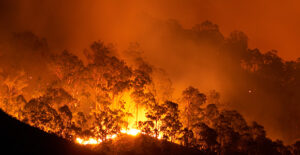Australian Bush Fire Outlook – Spring 2023
NSW Large areas of central and northern NSW are expected to see an increased risk of fire in spring 2023.
ACT – Normal bushfire risk during spring is expected for the ACT.
The long-range outlook for spring predicts drier and warmer conditions, raising the possibility of increased bush and grass fire risks for summer.
Victoria – A warmer spring and earlier start to the high-risk fire season is expected this year, following three years of lower fire-risk seasons as a result of La Niña conditions.
Tasmania – Normal bushfire risk is predicted for spring. Drier, warmer conditions and an abundance of fuel will increase bushfire risk towards summer.
South Australia – Above-average rainfall has rapidly switched to below-average rainfall and drying out of soil in many areas of the state. Much greater fuel loads are present, requiring greater efforts for hazard reduction throughout spring before the hotter weather arrives. SA is expecting well above-average maximum temperatures and above-average minimum temperatures in spring.
Queensland – The combination of drying fuels, forecast below-average rainfall and above-average temperatures will likely bring locally intense bushfire activity. Bushfires may be destructive across parts of Queensland as vegetation becomes flammable during the spring months.
Northern Territory Drying conditions are predicted to impact the entire NT as El Niño continues to develop. Average grass fuel loads and adequate fire scar coverage across the Top End, Katherine and Arnhem districts mean these regions have normal fire potential. Above-average grass fuel loads, continuity of these fuels and high densities of invasive Buffel Grass have increased the risk for wildfires to travel across vast distances during spring.
Western Australia – Winter rainfall has been below average for southern WA and above average for northern WA. An above-average wet season in the Kimberley has delayed curing in the savanna grassland and subsequently the late dry season. For southern WA in late spring, drier and warmer conditions may contribute to higher surface fuel availability and make bushfires more difficult to suppress.
Bush Fire Planning Tips
You don’t have to live in the country to be at risk of fire. If you live near areas with significant bush, forest, long grass, or coastal scrub, you need to plan for the fire season.
Not everyone thinks clearly in an emergency. Taking steps to prepare before the fire season means knowing what to do when you’re at risk of fire. A written and preferably well-practised plan will help you remember what needs to be done during a crisis. Use the Bushfire Survival Planning template.
Key Steps
Why should I leave early?
Leaving early is the safest option to protect yourself and your family. Leaving early means leaving the area before there are any signs of a fire – not when you can see flames or smell smoke. Leaving early means avoiding panic, being trapped, making the wrong choices and risking serious injury or death.
Defending Your Property
Planning to stay and defend is a big decision. You could be at serious risk of death or injury from uncontrollable fires on Extreme and Catastrophic fire danger days. Most homes in bushfire-risk areas are not designed for Catastrophic conditions. The Defending Your Property page can help you decide whether or not you are capable of defending your property – and tells you about the risks and preparations involved.
How to plan
Taking steps to prepare before the fire season means knowing what to do when you’re at risk of fire. Every family or household is unique, so every fire plan will be different. The information and templates in the Fire Ready Kit and on this website are designed to assist you.
- Which Fire Danger Rating is your trigger to leave?
- Will you leave early that morning or the night before?
- Where will you go?
- What route will you take – and what is your alternative in the event that a fire is already in the area?
- What will you take with you?
- What do you need to organise for your pets or livestock?
- Who do you need to keep informed of your movements?
- Is there anyone you need to help or check up on outside your household?
- How will you stay informed about warnings and updates?
- What will you do if there is a fire in the area and you cannot leave?
Remember to decide who will do what as part of your plan.
Your destination and journey
Talk to your family and friends about how you’ll know when to leave and where to go to stay safe. When you leave early on a fire-risk day, it’s up to you to decide on a suitable place to go.
If you do not have friends or relatives in low-risk areas who you can visit, consider community facilities such as libraries, shopping centres, swimming pools or cinemas.
If you rely on others for care and support, your only safe option on serious fire risk days is to leave early – never wait to receive a warning.
Why write down your plan?
Would you remember a plan that’s just in your head if you’re surrounded by smoke, heat and flames?
The bushfire season is long and is getting longer, and 2023/2024 is expected to be drier and warmer than previous years.
A written plan will help reduce uncertainty and anxiety.
Remember, any bushfire plan – written or not – is better than no plan.
Contact Lewis Insurance Services on 07 3217 9015 or send us an email by clicking here, we can guide you with Emergency Planning and Business Continuity. We pride ourselves on being informed about risk and insurance and ensuring you have the right Insurance policy for your needs. This article was published by our AFSL Licensee, Insurance Advisernet Australia P/L, www.insuranceadviser.net
General Advice Warning
The information provided is to be regarded as general advice. Whilst we may have collected risk information, your personal objectives, needs or financial situations were not taken into account when preparing this information. We recommend that you consider the suitability of this general advice, in respect of your objectives, financial situation and needs before acting on it. You should obtain and consider the relevant product disclosure statement before making any decision to purchase this financial product.

